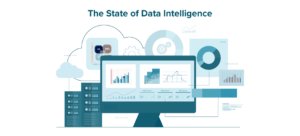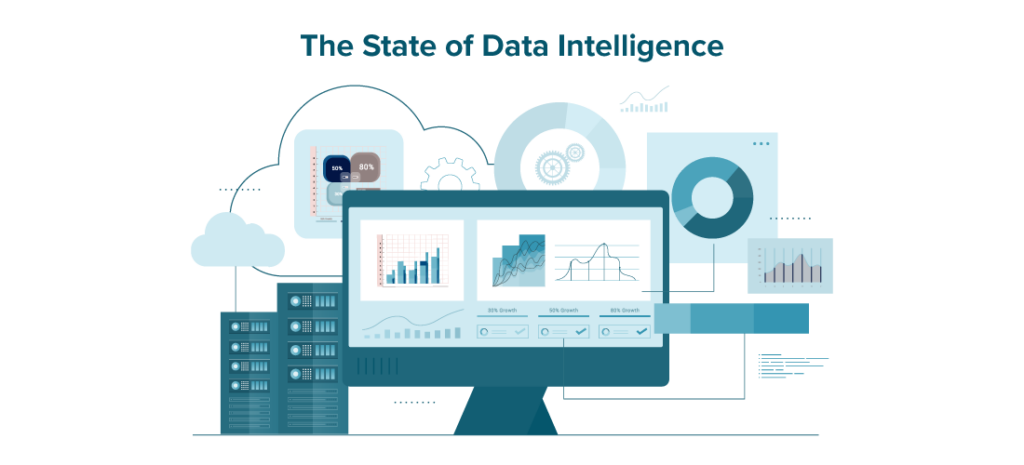
As companies increasingly look to maximize the business impact of their data, it becomes crucial to have a handle on their organization’s data and AI landscape. While tools and methods may change, business and IT professionals aim to improve their data intelligence with an eye towards reducing risk, lowering costs, identifying new disruptive opportunities and making better-informed decisions based on insights from their data.
In partnership with Enterprise Strategy Group (ESG), we surveyed 220 business and IT professionals across North America responsible for and/or familiar with their organizations’ data governance and intelligence strategies, investments and operations to keep a pulse on what they are experiencing and learn more about their current efforts to move their organizations forward in their relationships with data. While the 2023 State of Data Intelligence report contains more in-depth findings and analysis, let’s take a look at some of the key challenges organizations are facing when it comes to leveraging their data, the evolving role of data governance and the data intelligence strategies and maturity efforts that are driving impactful results.
Top data challenges organizations are facing
With overwhelming volumes of data and diverse and broad data landscapes to manage, organizations are tackling many challenges while working to make the most of the data available to their enterprises. Such as, can they trust the quality of their data? Is it easy to discover and translate into profitable insights?
While there are many reported challenges that plague organizations in their efforts, more than one-third of survey respondents cited data quality as the top challenge in supporting the strategic use of data across their organizations, followed by data visibility across their landscapes and trust in data concerns from data users.

Given its role as the top challenge cited for strategic data use, data quality also remained the top driver of data governance programs for the second year in a row according to 48% of 2023 respondents, rising in response from 41% in 2022.
Organizations are also increasingly relying on data governance initiatives to improve data security, boost analytics and maintain regulatory compliance. Regulatory compliance has shown a significant uptick in response compared to the previous year as businesses continue to face more privacy regulations and the growing likelihood of AI-related regulations.
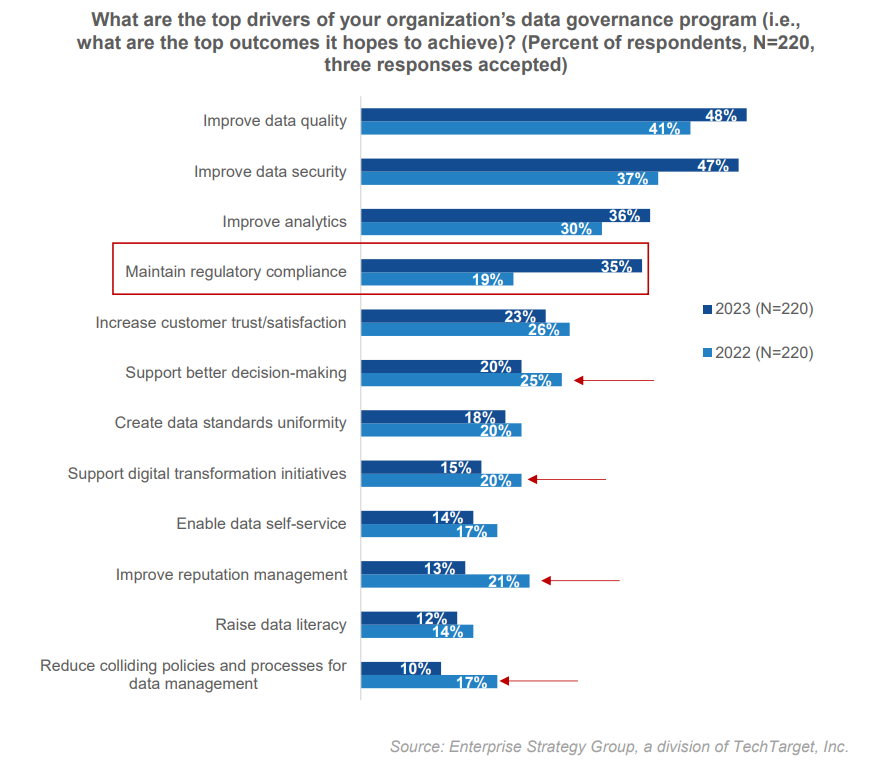
Data governance is evolving and expanding
It’s no secret that IT and business leaders often look to data governance to answer a differing set of needs and fuel a wide variety of business outcomes. These differences in perception were evident in how data governance was defined by IT decision-makers (ITDMs) versus line-of-business respondents (LOB).
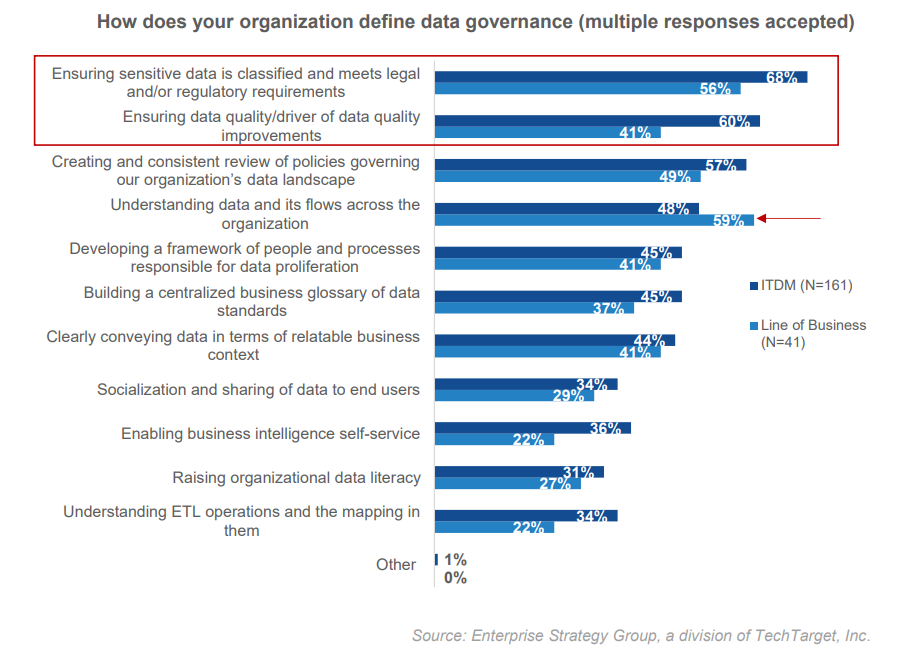
According to IT respondents, the top three defining characteristics of data governance are ensuring sensitive data is classified and meeting legal and regulatory requirements, ensuring data quality, and creating and consistent reviews of policies to govern the organization’s data landscape.
But, among business respondents, the top defining characteristic of data governance is understanding data and its flow across the organization.
So, what does this mean for your organization? As the role of data governance is viewed differently across your organization and no doubt counted on to deliver multiple outcomes, identifying organizational-specific data governance responsibilities and the top priorities for your data governance efforts is the first step of improving your organization’s overall data intelligence.
While traditional data governance efforts have centered around risk management and governance control, today’s modern data governance has expanded to encompass both offensive and defensive elements:
Offensive data governance
When your data initiatives are centered on enterprise data visibility, governed accessibility, data literacy, building data trust, and self-service and user empowerment in general, you’re pursuing offensive data governance. Your goals are to ensure data is used appropriately and to build internal confidence in the quality of data by demonstrating that it is trustworthy and consistent. Data-as-a-product, data valuation and monetization, and internal and external data marketplaces are all examples of offensive data governance in action to discover and strategically maximize the use of high-value data
Defensive data governance
When your organization is focused on risk management, data quality remediation, cost-effective data management, policy and enforcement controls, and regulatory compliance, then you’re engaged in defensive data governance. You put in place procedures and strategies designed to protect your data assets, comply with regulations and improve the integrity and accuracy of your data. At the same time, you’re upholding accessibility, privacy and trust in data by guarding against unauthorized access, data breaches and any misuse of your data.
This research enforces data governance is quickly evolving in its meaning and focus for organizations and driving a need for more precision and clarity in the development of data intelligence strategies by organizations to ensure all are aligned on the business outcomes most important to achieve.
Data intelligence strategies
A data intelligence strategy is a necessary component of managing and maximizing the strategic use of data enterprise-wide.
Yet less than half (45 percent) of surveyed companies stated they have a clear data intelligence strategy in hand. More than half (52 percent) claimed to have a loose strategy, were still planning a strategy or had no plans for one.
However, respondents who have implemented data intelligence strategies report ROI in these areas:
- Enhanced data visibility (47%)
- Cost savings through decision-making support (39%)
- Revenue growth through decision-making support (38%)
- Accelerated, proactive risk mitigation (36%)
So, what are they focused on? Respondents cited their main priorities as:

Maximize the value
of your data.
- Improving enterprise-wide data literacy (39%)
- Increasing the strategic use of high-value, governed data (36%)
- Enriching data quality (35%)
- Implementation of strong data governance practices (33%)
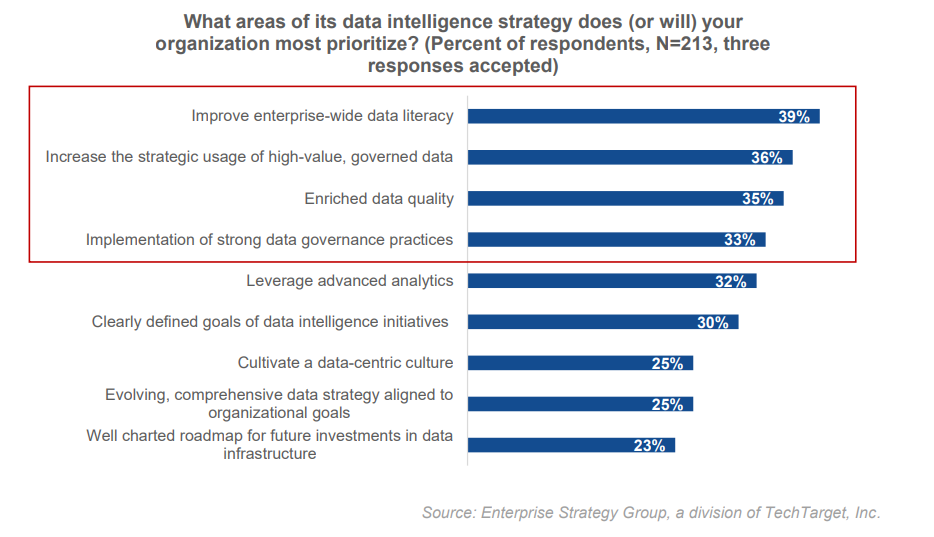
Your data intelligence strategy sets your organization on the path to data maturity and greater confidence in the accuracy and quality of your company’s data. It can make high-value data easily recognizable and accessible (with governance, of course) to more of the data users and decision-makers across your organization at a quicker pace. And, it takes into account the need to ensure diverse constituents across your enterprise – such as marketing, sales, operations, manufacturing and finance – all have the ability to quickly zero-in on the relevant data and insights that will drive the most positive outcomes within their specific arenas.
Lack of data visibility, understanding and self-service accessibility affects productivity
In a landscape of data silos, it’s difficult to make (and keep) trusted data assets visible enterprise-wide and ensure the context and governance is intact to inform its use. But in an environment of data maturity, users can easily find and shop for the high-value data to accomplish their tasks, benefit from data literacy aids like mind maps and data lineage and gain governed access quickly.
Respondents were clear in claiming self-service as having a positive effect on employee productivity. More than two-thirds (69 percent) of respondents whose data intelligence strategy resulted in positive ROI reported that productivity was greatly improved by self-service. Additionally, the research showed that with a self-service data marketplace, users are twice as likely to be able to access required data within one hour, and 90% more likely to have access to data within hours than users without a self-service data marketplace. Of those organizations that have a data marketplace currently, 79% believe self-service data marketplace capabilities have a significant or game-changing impact on data users’ efficiency and innovation.
Conclusion
As your organization’s data landscape evolves, so must your data governance and data intelligence strategies and capabilities to ensure you take advantage of and responsibly protect the data at your disposal. Assessing your organization’s current state, benchmarking against peer organizations with research, taking advantage of new self-serve marketplace capabilities and driving towards developing a clear and focused data intelligence strategy to identify the business outcomes most important to your organization are critical to your data maturity.
